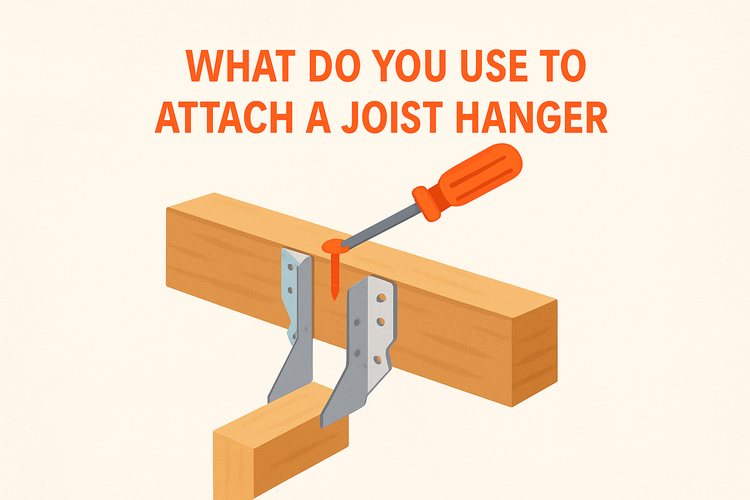What Do You Use To Nattach A Joist Hanger

Choosing the Right Fasteners for Joist Hangers
To properly secure a joist hanger, selecting the correct fasteners is crucial. This ensures structural integrity and safety during and after construction.
The most commonly recommended fasteners for joist hangers are nails or structural screws. Specifically, galvanized nails—such as 10d, 16d or their equivalent—are often used, depending on the size and load rating of the hanger. Alternatively, structural wood screws offer increased shear and withdrawal strength. Choosing between nails and screws can depend on accessibility, load requirements, and the type of timber or support structure being used.
It’s essential to avoid using drywall screws or other non-structural fasteners, as they do not provide the necessary holding power and may lead to failure over time. Most [Joist Hangers](https://jandeconstruction.co.uk/collections/joist-hangers) are rated for a specific fastener size, and deviating from this recommendation can compromise the performance of the system.
Why Fastener Type Matters for Structural Safety
The effectiveness of a joist hanger largely depends on the fasteners used during installation. Structural failure can result if improper fasteners are applied.
Joist hangers are typically tested and rated based on specific fasteners—these fasteners, when used correctly, help the hanger meet its published load requirements. Using undersized, soft-metal, or mismatched screws or nails undermines the structural rating, leading to vulnerabilities in the timber frame system. For projects exposed to moisture or external weather conditions, corrosion-resistant fasteners, such as hot-dipped galvanized nails or stainless steel screws, are necessary to prevent long-term deterioration.
Fasteners must penetrate deep enough into both the hanger and the support structure, such as beams or ledger boards. This depth ensures that the forces transferred by the joist into the hanger are effectively distributed into the supporting timber element. Coupled with quality [Screws and Nails](https://jandeconstruction.co.uk/collections/screws-nails), the structural system can endure loads, vibrations, and even changing environmental conditions.
In safety-critical applications, it’s recommended to use fasteners from the same manufacturer as the joist hanger, as these are tested together for optimal performance. Otherwise, at a minimum, verify compatibility through code compliance tables or engineering specifications.
Installation Techniques for Maximum Performance
Correct placement of the fasteners is just as important as the fasteners themselves. Even with high-quality screws or nails, poor positioning can undermine the efficiency of the joist hanger.
Start by ensuring the joist hanger is flush with the ledger or beam. This provides a stable base and ensures the load is transferred directly without bending or twisting forces acting on the fasteners. Each slot or hole in the hanger is carefully designed to align with specific shear paths and tension forces. Therefore, filling all holes with the designated fasteners is essential for load distribution and compliance with structural codes.
For harder timbers or when using screws, pre-drilling might be necessary to avoid splitting. Additionally, when using screws, it's best to employ structural types with hex or star-drive heads to prevent cam-outs and ensure proper torque. You may also want to use angle brackets in conjunction with joist hangers to provide lateral bracing and increase rigidity. View selections at [Angle Brackets](https://jandeconstruction.co.uk/collections/angle-bracket).
Tools and Materials Needed for Joist Hanger Installation
Installing joist hangers efficiently requires the right blend of tools and hardware. Using incorrect equipment can lead to misaligned hangers or compromised fasteners.
Common tools include a hammer or framing nailer for nails and an impact driver or drill for structural screws. Additionally, a carpenter’s square, tape measure, and level ensure precise alignment and spacing between hangers. It's also wise to use clamps during the setup so the hanger stays positioned correctly as you begin driving in the fasteners. These simple tools preserve accuracy, especially when dealing with multiple hangers across a support beam.
When building extensive frameworks, also consider using restraint straps or timber connectors to further reinforce the frame. For additional support of timber loads or mounting base structures, [Post Base](https://jandeconstruction.co.uk/collections/post-base) components are often integrated as well.
Inspection and Maintenance of Joist Hanger Fasteners
Initial installation isn’t the only phase where fasteners matter—ongoing inspection ensures long-term structural safety.
Fasteners may become loose over time due to timber shrinkage, temperature changes, or vibrations in the structure. Regular inspections should look for signs of corrosion, loose connections, and timber splits around fastening points. If decay or rust is found, the damaged fixings should be replaced with corrosion-resistant options, and the adjacent timber assessed for rot or moisture damage.
In areas subject to high winds or heavy load-bearing requirements, integration of [High Wind Ties & Timber Connectors](https://jandeconstruction.co.uk/collections/high-wind-ties-timber-connectors) provides further peace of mind. Inspect these in tandem with joist hanger installations to ensure all points of the structure are maintaining integrity over time. This kind of proactive checkup is key for both domestic and commercial timber builds.
